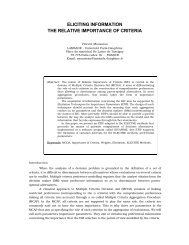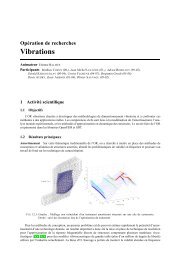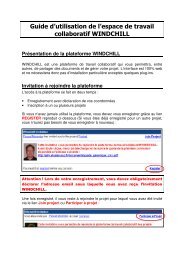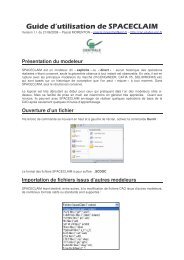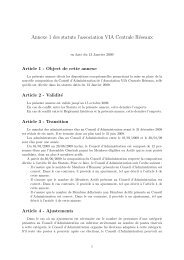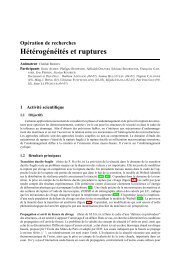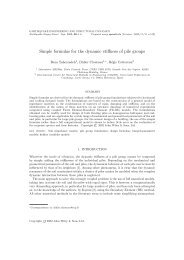View - Ecole Centrale Paris
View - Ecole Centrale Paris
View - Ecole Centrale Paris
You also want an ePaper? Increase the reach of your titles
YUMPU automatically turns print PDFs into web optimized ePapers that Google loves.
DB2SNA: Extraction and Aggregation of Social Networks from DB 19chose to aggregate our graphs with the k-SNAP algorithm because it permits anaggregation on the both kind of information : links and attributes.Let use recall here the basic concepts of graph theory. A graph G is definedas a pair of sets: G = (V,E) , where V is the set of vertices or nodes, and Ethe set of edges or links which connect vertices. The two vertices connected byan edge are called endpoints of this latter. Conversely, the edges connecting avertice to the other vertices are called incident edges of the node. A graph canbe directed or undirected. In the first case, also called digraph, an edge is denotedas pair (v,w), where v is the origin and w the target, and in the social networksframework it means: “v is in relation with w”, the opposite being true if andonly if there exists an edge (w,v). If the graph G is undirected, then an edge isdenoted as the set of its vertices: {v,w}. Most of the times, vertices are labelled,but it can also be the case for edges, then G is called a labelled graph. Moreover,if exists a function ω : E → R that assigns a weight for each edge, then G is aweighted graph. Two vertices v and u are called neighbors or adjacent, if they areconnected by an edge. The set of neighbors of a node v, denoted Γ(v), is calledits neighborhood. The topology of the graph can be captured in the adjacencymatrixA, where the element a i,j is equal to one when (v i ,v j ) ∈ E, and zerootherwise.From here, when we denote a graph by G = (V,E) with V the set of nodes,the set of edges will be E = {E 1 ,E 2 ,.....,E r } the set of edge types, with eachE i ⊆ V ×V representing the set of edges of a particular type.And each node of V will be characterized by a set of attributes Λ(G). For aset of attributes A ⊆ Λ(G), a function Φ defined on V which is called AttributesCompatible Grouping or simply A-compatible, if it satisfies the following condition:∀u,v ∈ V,ifΦ(u) = Φ(v) then ∀a i ∈ A,a i (u) = a i (v), it will be simplydenoted by Φ A . This function induce a partition {g 1 ,g 2 ,...g k } on V where ineach group g i , every node has exactly the same values for the set of attributesA.In fact, The A-compatible Φ A only considers the node attributes. However,nodes do not just have attributes, but also participate in pairwise relationshipsrepresented by the edges.Forthat, weconsidernowrelationships whengroupingnodes.Foragrouping,we denote the neighbor-groups of node v in E i as NeighborGroups Φ,Ei (v) ={Φ(u)|(u,v) ∈ E i } which represents the set of groups on the partition associatedwith Φ where at least one element is connected to v by the relation E i .4.1 Attributes and Relationships Compatible GroupingForasetofattributesA ⊆ Λ(G)andasetofrelationsR,agroupingiscompatiblewiththesetofattributesAandrelationshiptypesRorsimply(A,R)-compatible,if Φ satisfies the following conditions:1. Φ is A-compatible,2. ∀u,v ∈ V if Φ(u) = Φ(v),



